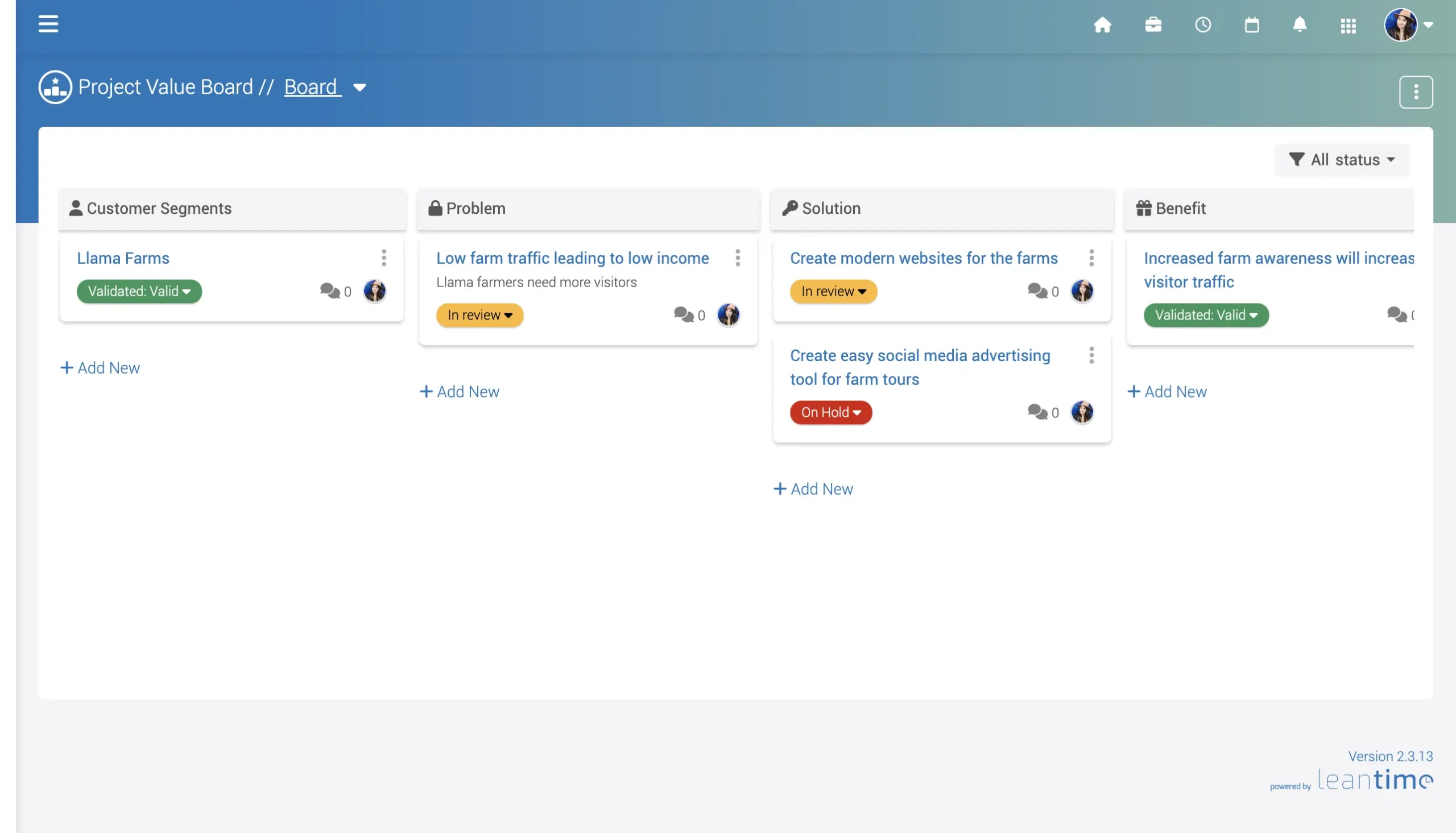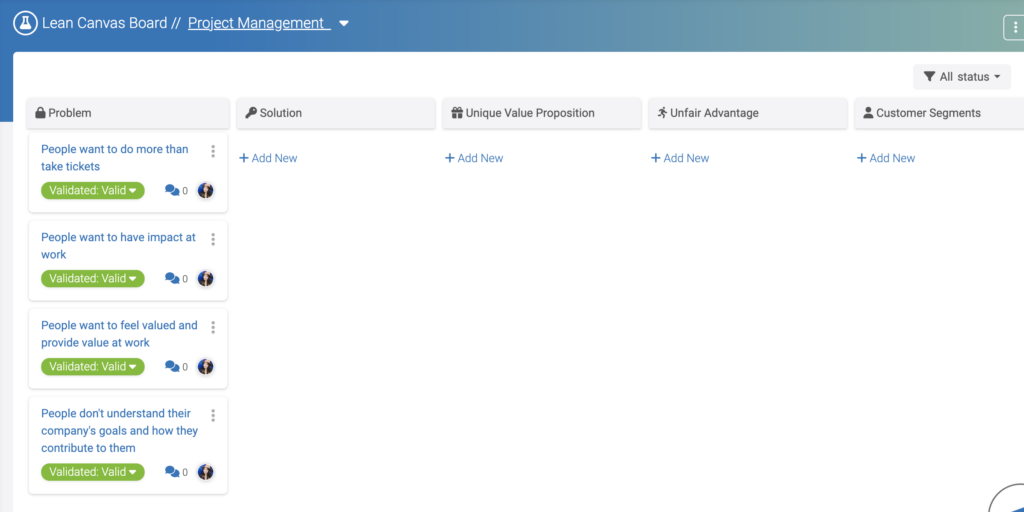Estimated reading time: 6 minutes
In the ever-changing world of innovation, a well-defined roadmap is essential to steer a startup towards financial sustainability. The Lean Canvas model does just that – it is a valuable one-page template for brainstorming early-stage business models.
It’s designed to be an ever-evolving blueprint that assists entrepreneurs in validating their ideas, mitigating risks, and iterating their business models. Its approach calls for concise content, making it a practical framework to outline your business concept. And most importantly, it enables you to align strategies with market demands.
Below we take a look at how to complete the Lean Canvas tool.
How To Use the Lean Canvas Template for Business Model Development

As mentioned above, the Lean Canvas is a strategic management tool that helps startups and entrepreneurs develop a concise and actionable business plan. It is divided into several blocks, each focusing on crucial aspects of a business model.
Let’s take a look at each block:
Problem
Identifies the top 3 problems and pain points that your target audience experience. The end goal is to understand their problems better and identify how your solution solves their problems / and alleviates the pain.
Solution
Clearly outline your business solution and/or product offering that solves the problems your customers are experiencing. Describes how your solution effectively meets the market’s demands.
Learn More: Lean Canvas Model: Crafting Solutions and Prioritizing Features
Key Metrics
Determines the key performance indicators to help you measure your business’s performance and progress. These metrics inform your business development.
Unique Value Proposition (UVP)
Define what sets your business apart from competitors and why potential customers will choose your product or service.
Read More: What Is Unfair Advantage in Lean Canvas?
Channels
Highlights the channels you intend to reach and engage your customers. This may include online platforms, partnerships, or direct sales channels.
Customer Segments
Specifies the different market segments you plan to target. This block helps you understand your primary audience, which is critical for tailoring your offering. Learn how ‘customer segments’ can impact your business success and optimize your strategy accordingly.
Cost Structure
This breaks down the expenses involved in operating your business. This includes production costs, marketing expenses, and other relevant financials.
Read More: The Cost Structure Lean Canvas
Revenue Streams
Outline the sources of revenue for your business. This may include sales, subscriptions, licensing fees, or any other means through which your business generates income.
What are the benefits of using the Lean Canvas?
Ash Maurya pioneered the Lean Canvas model as an invaluable tool for startups using the Lean Startup methodology. By filling out the one-page lean canvas, you can clearly define your business model and identify any weaknesses or gaps in your strategy.
Read More: Startup Project Management: The Key to Success
The main benefit of the lean canvas is that it forces you to synthesize your business idea down to its core components. This includes identifying your target customers, the problem you are solving for them, your unique value proposition, the channels you will use to reach customers, and your revenue streams. Going through this exercise early on ensures your entire team has alignment on the fundamentals of your business.
Another advantage is that the lean canvas lends itself well to experimentation and iteration. As you test parts of your business model and gain new customer insights, you can quickly update your canvas to reflect pivot decisions. This builds momentum by keeping your team focused on the right metrics and priorities.
Tools to create a Lean Startup model
The advice has been, traditionally, to print out a lean canvas and post it somewhere to fill with sticky notes. This can often be challenging as teams are frequently remote and may need access to the information outside the office because the lean canvas should be tracked alongside progress.
Tools to create a Lean canvas online include project management tools like Leantime and tools like Leanstack.

Leantime Features Include
- • Task Management
- • Idea Management
- • Goals Tracking
- • SWOT Analysis, Empathy Maps, Project Briefs
- • Time tracking
- • AI Task Prioritization
- • Strategy Management
- • Program Plan management
- • And much more
Being able to map out your initial business model and then immediately connect it to a growing business is a unique value proposition of using a tool like Leantime. It’s an ideal companion to both growing and developing your business ideas simultaneously. Quickly see the progress and keep the growth on track with our features.
In Summary – Optimize Business Development with the Lean Canvas
Overall, the lean canvas model perfectly complements the Lean Startup approach. Enabling fast learning and adaptation increases your chances of finding product-market fit and launching a sustainable, scalable business.
Completing the Lean Canvas template helps create a comprehensive understanding of your business model and guides strategic decision-making. Regularly revisiting and revising (also known as iterating), the canvas keeps your business strategies aligned with market dynamics and ensures that you’re on the path to scale and grow.
Using the Lean Canvas framework is a proactive way to advance your business model, sets the stage for informed decision-making, and helps define an adaptable business model that stands the test of time.
Explore More About Lean Startup Philosophy — we’re passionate about helping you navigate the world of entrepreneurship and innovation through the lens of the Lean Startup methodology.
Frequently Asked Questions
The 9 sections are Customer Segments, Problem, Unique Value Proposition, Solution, Channels, Revenue Streams, Cost Structure, Key Metrics, and Unfair Advantage.
It’s best to complete your initial lean canvas during customer discovery and before building your minimum viable product (MVP). Revisit and iterate on it throughout product development.
The goal is to summarize your business model at a high level on one page. Capture the essential elements without going into too much depth.
The lean canvas is meant to complement a business plan, not serve as a comprehensive plan itself. Use it to align your team and identify gaps before creating your full plan.
Yes, the canvas should evolve as you learn from experiments and make pivots. Review and update it frequently to stay on track.
Here are some other links you may be interested in…
- Lean Business Solutions
- Understanding the Lean Canvas: The Blueprint of Modern Lean Innovation
- Creating a successful startup: Business development tools to prevent failure
- Crafting Solutions and Prioritizing Features with the Lean Canvas Model for Effective Business Development
- Communicating Business Development with the Lean Canvas






